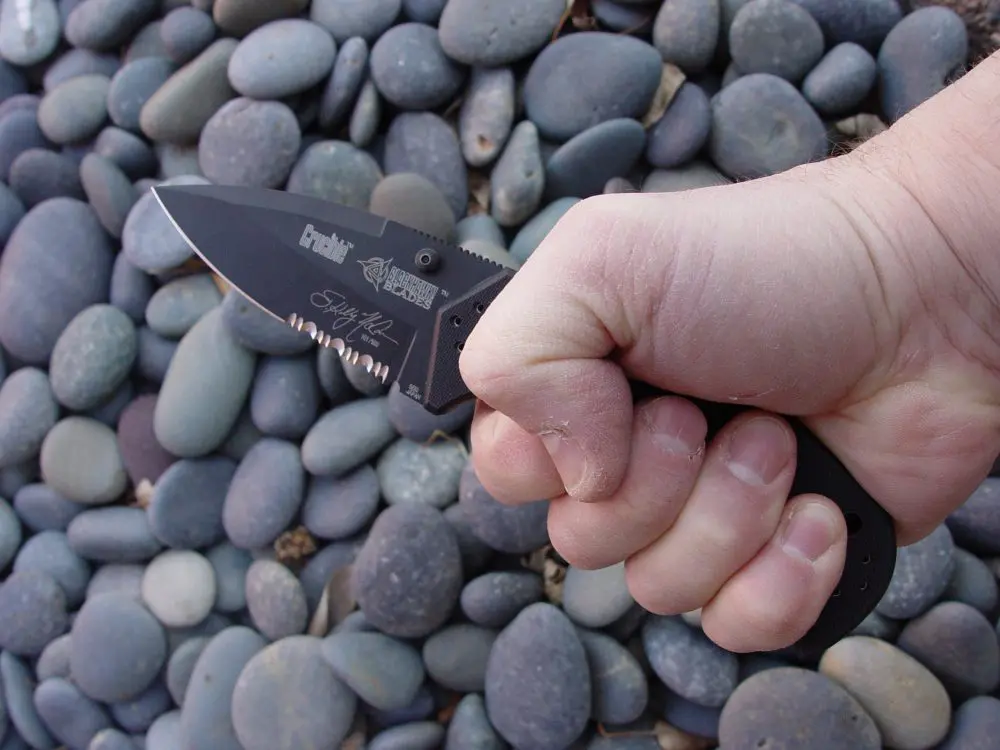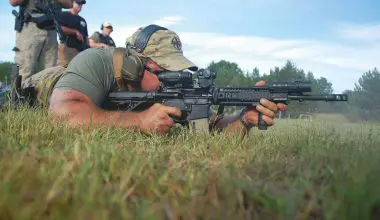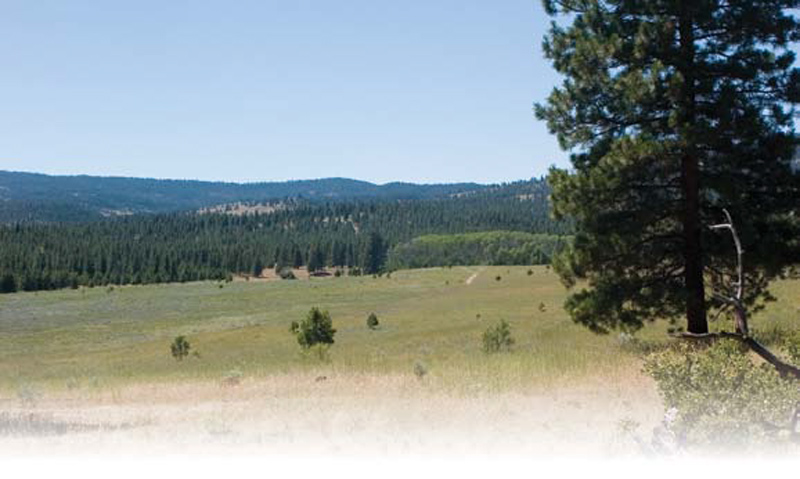
When instructor Caylen Wojcik made that blunt off-hand statement during the opening moments of his four-day Precision Long Range Rifle class, I knew I was going to like the guy. Four days later, simple affinity had transcended into profound respect. It seemed apparent that I was witnessing the first steps of what will likely become a long and successful journey in the tactical training industry.
Like others who have taken recent real-world experience into the training field, Wojcik is a 30-year-old former U.S. Marine Scout-Sniper who opened Central Cascade Precision (CCP) in central Washington state to teach shooters the fine and sometimes arcane art of longdistance shooting.
Wojcik is a lifelong shooter and biggame hunter who knew at age 16 where he was headed after reading Marine Sniper: 93 Confirmed Kills, the bestselling book about legendary Vietnam USMC sniper Carlos Hathcock. “As cheesy as it sounds now, I read the book and realized that is what I was going to do,” Wojcik says with conviction.
He got his wish. After attending boot camp and enduring one deployment as an infantry grunt, he became a scoutsniper in late 1999. Then after extensive schooling and a western Pacific deployment as a team leader, he spent three years as an instructor with the First Marine Division Scout-Sniper Basic Course.
At the school, Wojcik was eventually recruited to the third battalion of the First Division to serve as Chief Sniper in the Anbar province of Iraq. While in the sandbox, he got plenty of operational trigger time and something unexpected: an insurgent rocket that nearly cost him a leg.
Wojcik survived and remained bipedal, but could no longer serve in the Marine Corps. Overcoming the physical and mental challenges of his injury, he eventually realized his love of longdistance shooting still burned strong. “I have a real passion for long-range shooting. I was away from it for a long time, but came to realize that it’s such a big part of me, I can’t let it go,” Wojcik says.

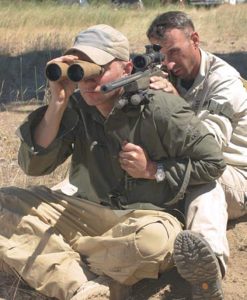
Table of Contents
CENTRAL CASCADE PRECISION
Taking the plunge of opening a shooting business, Wojcik started CCP in April 2010. Though he offers instruction in other areas such as defensive pistol, his specialty is the long-range shooting class.
The biggest problem facing any long-range rifle instructor is finding a place to shoot. Wojcik got lucky when a family friend offered part of his historic cattle ranch high in the mountains near Yakima, Washington.
The range looks more like the setting for a John Wayne movie than a training ground for shooters. Set in a large grassy meadow ringed by Ponderosa pine and groves of aspen, mule deer are frequent visitors, while the surrounding national forest is thick with Roosevelt elk. At night the occasional black bear wanders past the bleached rib cage of a cattle skeleton moldering in the grass. The only permanent signs of human habitation are rusty barbed-wire fences.
The firing area is a natural bowlshaped valley that allows several different configurations to challenge shooters. As Wojcik says, “This range is awesome. We can shoot out to 1,000 yards and through 270 degrees. The only things we have to worry about are the cows.
“I call this a sniper’s range,” he continues. “There are no range flags, no yard lines, nothing. This is exactly what you will be exposed to if you’re in a combat or hunting situation. The winds here do some funky, crazy things. If you can call wind here, you can call it any place in the world.”
Though the range is both challenging and spectacular, it is also somewhat out in the boondocks. The drive takes 40 minutes from Yakima following Wojcik’s directions and the occasional handmade sign. A GPS unit is a definite bonus.

TRAINING DAY ONE
On our first morning, after closing several of the ubiquitous cattle gates, we finally drove into the broad meadow and followed a dusty two-track lane through tall grass and blue mountain lupine to a knoll overlooking the valley. There we unloaded our cars and tried to focus on the task at hand rather than the magnificent scenery.
Ever the Marine, Wojcik started class promptly and students learned right away his no-nonsense approach to the fine art of precisely putting bullets into targets 3,000 feet away.
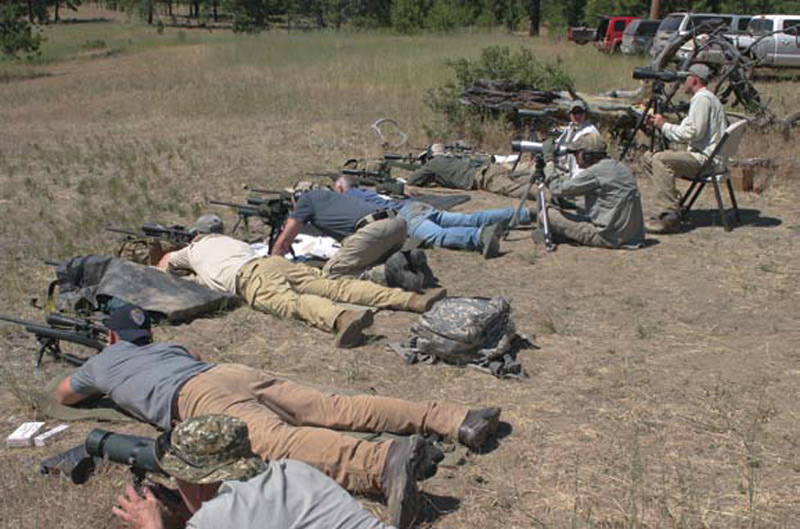
“We’re here to learn the basics,” Wojcik began as two hummingbirds flitted around the open nylon shelter that served as a classroom. “I am not here to teach you to be black-mask ninjas. The basics are where the core of everything lies. I believe that in order to have a good solid building, you have to have a rock-solid foundation. It’s my job to build that foundation.”
Continuing, Wojcik got to the crux of long-range shooting. “Consistency equals accuracy. Everything we do in long-range shooting requires consistency, which in turn gives us the accuracy we want.”
After another two hours of lecture on the basics of rifle marksmanship, it was time to open our gun cases and set up the firing points. The students, ranging from prior military to active-duty cops and a sprinkling of precision-rifle enthusiasts and hunters, brought an assortment of experiences to the firing line.
Following a military-style safety lecture, the first drill was to verify the zero of our rifles. For this class I shot a G.A. Precision HRT 100 rifle topped with a Schmidt & Bender scope provided by SureFire, which hosted the event.
Once everyone was satisfied with their weapon, we began shooting known distance targets out to 800 yards. Between 100 and 300 yards, we fired on paper targets that would more precisely register our hits, but thereafter switched to 18”x24” steel plates. The steel plates approximated the size of a human torso and were covered with a fresh coat of white spray paint after each round to clearly show the bullet impact.
Under Wojcik’s tutelage, all shooters were producing tight groups by the end of the day. We adjourned for the long drive back to Yakima to clean rifles, shower the omnipresent gritty dust out of our hair and enjoy a short nightcap.
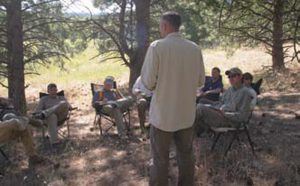
TRAINING DAY TWO
Day Two was spent reinforcing the lessons of Day One and finalizing longdistance “dope” (scope settings) on our rifles. Throughout the firing drills, Wojcik patiently worked with shooters who developed problems and corrected any mistakes he saw. Unlike the Marine Corps, the firing line was relaxed and shooters worked at their own pace to refine skills that allowed them to make consistent hits on the steel at impressive distances.

After a dinner break of authentic, cooked-on-the-spot carne asada, twilight fell and we geared up for the night shoot. Derek MacDonald of SureFire had brought along several products, and shooters got to ping steel in the purpleblack mountain night using both white light and the AN/PVS-14 and -22 night vision systems. Mounted on forward rails, these systems allow shooters use of their normal optics to easily place rounds in near-total darkness.
Perhaps the most interesting course of fire involved the Hellfire Heavy Gun WeaponLight system, used extensively by the U.S. Military. This 3,000-lumen, ten-pound super-spotlight allowed shooters to easily identify and hit the 800-yard target using their regular rifle optics. Using the attached IR filter in combination with the night vision gear on the rifles made the shooting seem almost too easy, despite the fact that bystanders could perceive no discernible light.
We also used the new SureFire Stratum handheld lights. With a three-position switch that varies from 50 to 160 lumens, it proved invaluable on the firing line. The low setting provided enough light to manipulate gear without a filter and without blinding anyone, while the high-power setting proved significantly brighter than the ubiquitous SureFire 6P LED light.
TRAINING DAY THREE
On Day Three, shooters were faced with a complete reversal of the firing range that removed any distance references or landmarks the students had developed during the previous two days. After a lecture that covered wind formula and how to “call wind” for a shooting partner, we laid back down behind the rifles and worked together in twoman teams to place bullets out to 1,000 yards. The afternoon was spent working on distance estimation using both electronic devices and scope reticles as the jagged “Tunk!” of bullets meeting steel echoed throughout the valley.
TRAINING DAY FOUR
Day Four covered positional shooting and man-versus-man drills that pitted students against each other on numbered unknowndistance targets. True to Caylen’s word, by midmorning the wind on the range was actually blowing in three different directions, and targets beyond 500 yards required careful wind calls in order to make hits.
As the afternoon drew to a close, students spent the remaining time in free practice then collected gear, received their certificates, conducted a round of hearty handshakes and closed the cattle gates behind them for the last time.

REFLECTIONS
Facilities
On the long plane ride home from Yakima, I contemplated several important points about my experiences with CCP. First is the forewarning that the facilities, compared to those at other shooting schools, are virtually non-existent.
The school amounts to a pop-up sun shelter in a remote mountain valley with a plastic portable toilet as the only semipermanent structure. The firing lines are wherever Caylen plops the shooters down, the only water is whatever currently resides in your canteen, and driving back to town for any forgotten or broken gear is out of the question. These facts are not an indictment of CCP, but rather an accurate description of the school’s physical plant, or lack thereof.
In fact, these things shouldn’t necessarily be considered shortcomings. If things like climate-controlled range buildings and a fully staffed pro shop are important selling points to you, you might want to look elsewhere. However, if self-reliance gives you a warm glow inside and contending with Mother Nature in all her varied moods enhances your life experience, a CCP class would certainly prove satisfying.

Instruction
Regardless of amenities, much more important to any training is the quality of instruction. This is where Caylen Wojcik excels.
His knowledge of the complex subject matter is superb, as are his depth and breadth of experience. Yet even above his technical expertise are his abilities to coach and mentor students.
In teaching persona, Wojcik is very much a product of his Marine Corps days. He moves briskly through the well-rehearsed and carefully honed lesson plan, with no extraneous off-topic pauses or superfluous war stories, and confirms that the class understands each point of discussion. He is patient and never seems to get annoyed at questions raised by students. In presentation, he is the epitome of a professional shooting instructor, remarkable in such a relative newcomer to the firearms training industry.
In addition to his squared-away demeanor, it’s evident that Wojcik is filled with the enthusiasm and fire that drive all great instructors. He appears to genuinely love what he is doing and inspires trust, respect and a similar passion to learn within his students.
In the end, waiting at the baggage carousel following 14 hours of air travel, I came to a simple conclusion: If you want to become proficient in long-distance marksmanship in a beautiful rustic Western setting with a “young gun” instructor whose stock is only going to rise within the shooting industry, we heartily recommend Caylen Wojcik’s Central Cascade Precision.
Just make sure you bring plenty of water.
